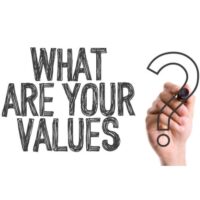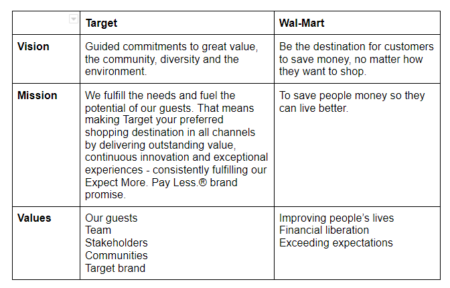Patrick Lencioni may have said it best in his book The Five Dysfunctions of a Team (2002), when he stated “If you could get all the people in an organization rowing in the same direction, you could dominate any industry, in any market, against any competition, at any time.” While this can be a daunting task, a leader will never achieve it without having a clear vision, mission, and values.
 Some of the most important documents of an organization are its vision, mission, and values statements. However, not only are these often overlooked, especially by small and mid-sized businesses, leaders don’t spend enough time reflecting on what each of these actually says about the organization, and more specifically, their leadership. Most leaders focus on their daily practices as a reflection of their leadership, without realizing that the vision, mission, and values of an organization actually drive their daily practices.
Some of the most important documents of an organization are its vision, mission, and values statements. However, not only are these often overlooked, especially by small and mid-sized businesses, leaders don’t spend enough time reflecting on what each of these actually says about the organization, and more specifically, their leadership. Most leaders focus on their daily practices as a reflection of their leadership, without realizing that the vision, mission, and values of an organization actually drive their daily practices.
While people usually discuss vision, mission, and values together, each plays its individual role in shaping the behavior of each individual within the organization. While the vision and mission are equally important, it is the values of the organization or your specific team that will be my focus.
Values shape what you do and how you do it.
It is essential that the organization has both a vision and mission statement that helps direct each employee’s activities. However, you don’t have to stop there. Each team can develop its own vision and mission that both focus on the specific role of the team as well as how the team fits into the business. These are so important in fact, that we, at Behavior Leader, suggest every position within the organization has its own vision and mission statement. This helps align each person’s purpose within the company as well as provides each employee with the specific information needed to get excited about their role.
So what is the difference between a vision and a mission?
Let’s make sure we are in agreement with the difference between the vision and mission. The vision is the future anticipated outcome for the organization. It describes the desired end state of the business in terms of what the leaders hope the business will be, given a perfect world. It should be inspiring, far-reaching, simple, and bold.
Ikea provides an excellent example of a vision statement: To create a better everyday life for the many people.
TED, which stands for “technology, education, and design”, from which the famous TEDTalks, were developed provides another excellent example: We believe passionately in the power of ideas to change attitudes, lives, and ultimately, the world.
Now, who doesn’t actually want to work for a company that is changing the world for the better?
The mission statement details how your organization will carry out its vision. It provides the how and the what of the organization. To put it another way, if you carry out the mission, you will get closer to realizing the vision.
Using our examples from above, Ikea’s mission statement tells us how they will create a better everyday life for many people: Offer a wide range of well-designed, functional home furnishing products at prices so low that as many people as possible will be able to afford them.
Simply put, they will realize their vision by making excellent furniture that people can afford.
TED, on the other hand, tells us how they will change the world with their mission statement: Spread ideas.
Building on this, the values tell employees the way to do the activities of the mission. If you’ve ever heard someone say “this is the [organization] way”, they are referring to the values of the organization. Values also tell employees what is most important to the organization as well as what is most important to you, as a leader. Examples of values include data-driven decision making, valuing customers, inclusion of everyone, and integrity.
Many leaders do not focus on values often. Instead of values being viewed as a driver of employee performance, they view them as an afterthought. The mistake is not understanding just how powerful values can be when they become the focus of the leader.
Three ways values help leaders.
Values tell employees how to prioritize, leading to both higher effectiveness and satisfaction.
For example, if an employee knows that customer service is one of the organization’s values, they know they should prioritize a customer complaint overproduction. While both are important, they are able to make the decision without coming to you for guidance. This leads to more autonomy, better services, and happier employees.
Values create ownership and buy-in.
When employees understand the priorities and foci of the team and organization, they can easily identify how each of these relates to them individually as well as their position and job tasks. The more one embraces the values of the organization or the team, the more ownership and connection they feel. It is the ownership and buy-in that create employees who discuss “their way” or “their team’s way” of doing things. This shows pride and dedication to getting things right, which, in the end, leads to better productivity and longevity of employees.
Values tell employees how you are different from others.
Let’s face it. Chances are your organization is not completely unique in the services you provide or the products you create. In today’s market, every organization needs to know exactly how they are different from their competitors. Values not only help shape how the organization is different overall, but immediately tell employees and consumers alike what makes you, as the organization or leader, different. Take the following example. Target and Wal-Mart are similar stores. Yet while they offer similar products, they attract different consumers. Why? They have very different visions, missions, and values. They are listed in the table below for comparison.

Examination of these two brands side-by-side illustrates why the consumer experience is different at each store. At Wal-Mart, the clear focus is on providing the lowest prices possible so that people’s lives are improved. At Target, the focus is on providing an exceptional shopping experience. Both stores highly value their consumers; however, for different reasons. Examining these, it is evident that leaders at each of the respective stores likely focus on different priorities and train their staff to interact with consumers differently. Wal-Mart staff are likely to focus on finding the best price, while Target employees may focus on ensuring you can find items easily.
As a leader, how much time are you spending reflecting on, discussing, and living by the values of your organization and team? Do you talk with your employees about the values and provide feedback regarding their performance as it relates to these values? If not, incorporating this into your daily practice will help increase employee buy-in, longevity with the company, and overall satisfaction with their position; all of which increase overall performance.




